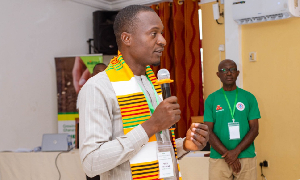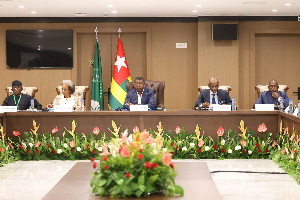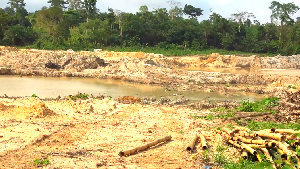“I am deeply mindful that this is a “timorous soul” or “bold spirit” moment, to borrow the famous categories memorably formulated in Candler v Crane, Christmas [1951] 2 KB 164 at p.178 by Denning LJ (as he then was). I am on this occasion inclined to be a bold spirit and not to succumb to what would be a stunning failure of strategic vision of Re Akoto ([1961] GLR 523) dimensions” - DR. S. K. DATE-BAH, JUSTICE OF THE SUPREME COURT
His Lordship, Dr .S.K Date-Bah, certainly wasn’t pleased with his Supreme Court colleagues when they decided they way the did in the Anane Case. The majority decision was “a stunning failure of strategic vision”. His reference to Re: Akoto makes this point clearer. Re:Akoto is case noted for its fame or infamy in the constitutional law and history of Ghana. It represented a lost judicial opportunity to chart a course for our country that could well have changed the development trajectory of the judicial protection of our rights and liberties. When I say a case is re:akotoed I use it in the sense of “a stunning failure of strategic vision”.
Re:Akoto involved Opanin Baffour Osei Akoto, Senior linguist of the Asantehene, and eight others, namely, Peter Alex Danso,Osei Assibey Mensah,Nana Antwi Bosiako,Joseph Kojo Antwi-Kusi,Benjamin Owusu,Andrew Kojo Edusei,and Halidu Kramo, who in 1959,were detained under the Preventive Detention Act(PDA). When the constitutionality of their detention was challenged in the Supreme Court of Ghana, the court upheld the constitutionality of the PDA. In consequence, the Supreme Court gave the green light to the incarceration of Ghanaians without formal charge or trial for a maximum period of 5 years. What was bad about Re: Akoto was that although the Supreme Court was presented with enough legal resources in the able arguments of Dr. J.B Danquah, to decide otherwise, the court ceased to grab the opportunity to so act. In the result, it failed to trail the blaze of freedom for Ghanaians with serious consequences for our civil liberties under PDA.No wonder Re:Akoto is largely viewed with disfavour in the annals of Ghana’s constitutional law and theory.
When a case is “re:akotoed” the decision-maker assumes an adjudicatory mode that is “Re:Akoto-like”. The decision-maker fails to take into account other relevant considerations. The decision-maker cuts a vision that is tunnel-like. Once in that tunnel he or she does not see or consider any other relevant considerations. It is like the ostrich burying its head in the sand, and the only reality it sees is the reality encased in the sand.
The decision of the Supreme Court in Republic v. Fast Track High Court,Accra,Exparte Commission of Human Rights and Administrative Justice[Anane Case][2007] is “re:akoto-like.” The court was presented with a good opportunity to empower CHRAJ in its investigative mandate against corruption and abuse of power thereby adopting a strict stand against corruption but it flunked this opportunity.
What is more, like a modern architect who had all the modern architectural tools to build for us an imposing and earth-quake resistant skyscraper, our Supreme Court only built a shaky shack that leaves all of us much the worse for it. The majority decision is incoherent and the reasoning, bad. It does not make the best sense out of the whole. Legal interpretation, particularly in the area of public law, no matter what theory of interpretation you adopt, should attempt to make the best sense out of the whole. You do this by showing that the epistemic quality of your reasoning is comprehensive, systemic, consistent and coherent. The majority decision fails this test.
Facts
Following media allegations of corruption against Dr. Richard Anane, the Commission for Human Rights and Administrative Justice (CHRAJ) instituted corruption and abuse of power investigations against him without any formal complaint from an identifiable complainant. This is not the first time CHRAJ has taken this course of action. In the past, it had taken a similar course of action against some public functionaries .We can easily call to mind the media allegations against Col. Osei Wusu and P.V Oppong in 1995. CHRAJ made adverse findings of perjury and abuse of power against Dr. Richard Anane, recommendations including the removal of Dr. Richard Anane from his ministerial post.
Decisions
Dr Richard Anane was dissatisfied with the CHRAJ decision and recommendations. He sought the intervention of the High Court. The court relying on the CHRAJ Complaint Procedure Rules, and apparently interpreting the word “complaint” in article 218(a) held that CHRAJ could not self-initiate an investigation under article 218(a) without any complaint from an identifiable complainant. The court quashed the CHRAJ findings, and literally ordered CHRAJ to remove the proceedings of the Anane case from its registry. The High Court orders against CHRAJ in effect meant the CHRAJ Anane investigations never started, never existed. It was an exercise in futility with no practical or legal significance.
Let’s take the reasoning of the High Court in the Anane Case as our starting point. The judge refers to the rules CHRAJ has made for the initiation and conduct of complaints. He states that the rules require an identifiable complainant to invest CHRAJ with the power to do an investigation under article 218(a). As nobody lodged a complaint with CHRAJ in respect of the alleged corruption by Dr. Richard Anane, there was no identifiable complainant. For this reason, CHRAJ did not have the power to go into the matter. In law we say CHRAJ acted ultra vires.
The judge is right! The CHRAJ rules talk about a complaint and a complainant. That said, his reasoning all the same abuses the rules of deduction/induction. His conclusion does not follow as a matter of logic from the CHRAJ rules he cites. The CHRAJ rules do not say that in all investigations CHRAJ conducts, there must be an identifiable complainant. The judge also seemed to have assumed that once the CHRAJ rules do not say CHRAJ can investigate a matter without an identifiable complainant then CHRAJ cannot so act. This is also an abuse of deduction. Whether or not CHRAJ has the power to conduct an investigation on its own has to be traced to all sources of law that have a bearing on the powers of CHRAJ, not just the CHRAJ rules. At least, it could be argued that the CHRAJ rules do not expressly address the issue at hand: whether or not CHRAJ can self-initiate a corruption inquiry based on mere newspaper allegations. If this is the case, we need to look elsewhere for an answer.
Our Supreme Court
Our Supreme Court also decided that for CHRAJ to “investigate complaints of violations of …corruption, abuse of power…”under article 218(a) there must be a complaint from an identifiable complainant. There was a lone dissentient, Justice Dr. Dateh-Baah .Now, let’s break down the decision of the majority for the purposes of analysis. I start with the lead opinion of Chief Justice Wood. The internal structure of her reasoning can be rendered as follows:
a. It is only the Supreme Court that has the power to conclusively interpret the Constitution.
b. CHRAJ can interpret the Constitution but it does so at its own risk especially if there are no prior pronouncements of the Supreme Court as to the meaning of constitutional provisions that call for interpretation.
c. The “practice and precedent” of CHRAJ is no bar to challenging the constitutionality of such “practice and precedent”.
d. In finding the meaning of complaint in article 218(a) of the Constitution she will limit herself to the scope of article 218.
e. A “contextual analysis” of the word “complaint” in light of the textual structure of article 218 demonstrates that complaint in article 218(a) has the meaning of “formal accusation”.
f. This meaning of ‘complaint” is reinforced by article 218(e) “which is the place for media and public fora allegations”. This is largely so because article 218(e) does not use the word “complaints” but uses the expression “investigate all instances of alleged or suspected corruption…”
g. The Chief Justice adds that “Had article 218(a) stood alone, had there been no article 218(e) my conclusions would have been different”.
h. The Chief Justice also conjures the picture of a doomsday scenario for our liberties if CHRAJ were to self-initiate allegations of corruption ,abuse of power etc.It will undermine a “friction free society” and lead to injustice. CHRAJ will have to monitor daily the entire media landscape and public fora across the entire country. CHRAJ can’t do this without being discriminatory and acting unconstitutionally. Here the CJ was essentially using policy arguments.
The members of the majority adopt a line of reasoning with similar effect as the Chief Justice’s. Despite the CJ waxing philosophical in her take on the thrust of the purposive approach to interpretation I think her hybrid theory of interpretation of combining “ plain-meaning and the subjective-purposive-based approach” needs deeper consideration. This is too technical to comment upon here. I leave that for another day and for a different forum .Her reasoning (and quite a number of recent Supreme Court decisions) smacks of formalism or neo-formalism. These are high sounding words but never mind if you are not a Jurisprudence Person! They don’t doesn’t really mean much.
Neoformalism
The internal structure of formalist or neo-formalist kind of legal reasoning is not any different from the internal structure of the reasoning in Re: Akoto. Legal formalism presupposes either consciously or unconsciously that legal rules/provisions are a complete “science” and all legal decisions can be deductively or inductively reached through logical legal principles. It applies legal rules with little consideration of the values etc the rules are meant to serve. It sees the legal rules as things in themselves instead of the values, purposes etc they are meant to represent. When the Chief Justice does her “contextual analysis”, and limits herself to article 218 she seems to neglect the fact that the 1992 Constitution is the embodiment of over 150 years of our constitutional, legal, and political history as a nation.Legal concepts have counter-concepts; legal principles have counter-principles; and rules have counter-rules. It all depends on the depth of your analysis and what legal tools you have at your disposal.
Legal reasoning is work
Legal reasoning is work .Not all judges are equally gifted as legal workers; otherwise we won’t have the Lord Dennings and the Kekewichs. Most often, when a judge engages in legal formalism or neo-formalism he/she abuses the rules of deduction/induction. That is conclusions are drawn that do not follow from the logical structure of the reasoning. What is bad about legal formalism is that it masks the reasons or policy justifications for the choices judges make. Often, it presents policy decisions as categorical legal rules that cry out for application because their turfs have been invaded by the legal issues at stake. Instead of our judges telling us they have made Decision A because of Reasons 1 , 2 and 3(privileging values, purposes over etc over legal rules ),legal formalism or neo-formalism presents Decision A as necessitated by the correct application of the law or by “contextual analysis”.
Anyone who has studied legal rules, principles and concepts with analytical depth knows there are gaps and even conflicts in the law. In public law such as constitutional law, contextual analyses in the form of textualism are not really the solutions to solving conflicting interpretations of constitutional provisions as such analyses tend to be inadequate. The analyst ends up assuming too much or artificially limiting the context. Instead of an objectifying approach to interpretation we get a subjective process of analysis without a clear cut-epistemic mode. We end up subjectifing a process in need of objectification.
Email: dusuuru_bamba@yahoo.com
Opinions of Friday, 4 July 2008
Columnist: Dusuuru Bamba
How the Supreme Court re: akotoed the Anane Case
Entertainment













